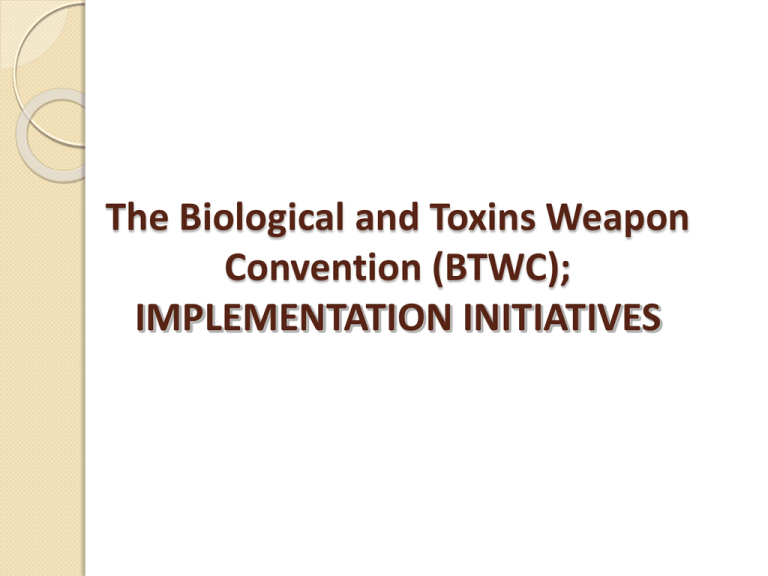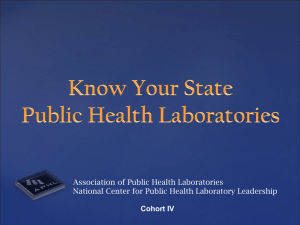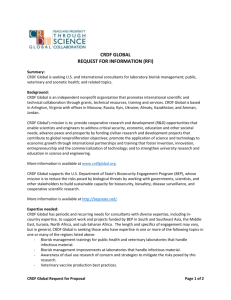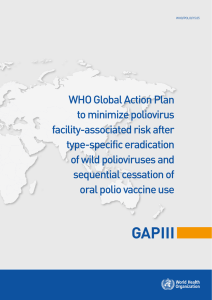Presentation on Bio Security - Pakistan Standards and Quality
advertisement

The Biological and Toxins Weapon Convention (BTWC); IMPLEMENTATION INITIATIVES The Biological and Toxins Weapon Convention • Convention on the prohibition of the development, production and stockpiling of bacteriological (Biological) and toxin weapons and their destruction. • Signed at London, Moscow and Washington on 10 April 1972. Entered into force on 26 March 1975. Depositaries: UK, US and Soviet governments. • Pakistan signed on 10-04-72 and ratified 25-09-74 Action to be taken by State Parties Legislation and other measures: Information and texts of specific legislation enacted or other measures taken by State’s Parties to assure domestic compliance with the Convention is to be provided to the United Nations Department of Disarmament Affairs Action required by State’s Parties: This could be usefully be reviewed annually and any new information and texts submitted to the United Nations Department of Disarmament Affairs Confidence building-measures: Submission of complete and timely declarations to the United Nations Department of Disarmament Affairs. Action required by State’s Parties annually by 15 April Pakistan’s Approach Pakistan shares the concerns of international community and is fully aware of its obligations Is implementing National Legislative and Administrative Measures Is concerned about the use of Biological Weapons or any Act of Bio-Terrorism Is doing its best to counter such threats by implementing stringent Bio-safety & Bio-security Measures Is enhancing capacity of its First Responders Has made appreciable progress in implementing legislation Is taking effective administrative steps for mitigation biological risks BWC Act is presently in the approval process Administrative Measures Designation of National Focal Point Inter-Agency Consultative Process Guidelines on Code of Conduct for Life Scientists Confidence Building Measures Oversight of Biological Research Activities. Education and Awareness Raising for Bio-Risk Management National Bio-safety Centre National Bio-ethics Committee National Awareness Activities Pakistan Population: 175 m GDP per Capital: 736 US$ Literacy Rate: 53 pc Universities/Institutes: 133 Biotech Institutes: 27 BIOTECHNOLOGY CENTERS Legal Instruments Pakistan Penal Code Drugs Act 1976 and Rules Plant Quarantine Act 1976 and Rules Animal Quarantine Act 1979 and Rules Anti Terrorism Act 1997 Pakistan Export Control Act-2004 Pakistan Export Control List-2005 and 2011 Pakistan Bio-safety Rules and Guidelines 2005 Draft BTWC Implementation Legislation Health Profile Pakistan: • 6th most populous country (175 million) Growth rate: • 1.73% - Doubling time 39 years Primary Healthcare: • Basic Health Units & Private Practitioners • Secondary & Tertiary care facilities in Urban Centres (Public & Private Sectors) • Health as a provincial subject since June 30, 2011: A new beginning! Communicable Diseases: • Water & Food borne infections, Malaria, TB, Hepatitis, HIV/AIDS, Hemorrhagic Fevers, Polio, Measles & other VPDs, Pandemic Influenza, other zoonotic diseases Chronic Diseases: • Diabetes, Heart Disease, Chronic Respiratory Disease, Cancer Epidemics and Outbreaks Investigated and Responded Livestock Sector Of Pakistan Population 67 million cattle/buffalo 90 million sheep/goats Production 46.4 million tons Milk 2.33 million tons Red Meat 0.77 million tons Poultry Meat 12.457 Billion Eggs Economic Importance 11.5 % of GDP 55.1 % of Agriculture Value Added More than 8.5% of National F.E. Earning More than 8 Million Families dependent Common Diseases Of Lifestock Foot & Mouth Disease (Ec+ TAD) Peste de Petits Ruminants (Ec + TAD) Contagious caprine pleuro-pnuemonia (Ec + TAD) New Castle Disease (Ec + TAD) Sheep/goat Pox (Ec) Haemorrhagic Septicemia (Ec) Black quarter (Ec) Enterotoxaemia (Ec) Mastitis (Ec) Anthrax (Z) Bovine Tuberculosis (Z) Brucellosis (Ec + Z) Avian Influenza (Ec + TAD + Z) Parasitic and Protozoan Diseases Pakistan’s Agriculture Contribution to GDP Livestock Major Crops 55.1 % 31.0 % Minor Crops Fisheries and Others 10.9 % 03.0 % (Wheat, Rice, Cotton & Sugarcane) 21.0 % Major Plant Diseases Rust in Wheat CLCV in Cotton Bunchy Top Virus in Banana Blight in Chickpea Number of R&D Organizations and Higher Institutes in Life Sciences Source: ISI Web of Knowledge (Jan. 2011) Bio-Industry A Private Sector Over View Health Sector Bio-Pharma Diagnostic Laboratories Vaccine Manufacturing Agriculture Sector Seed Companies Agro Chemicals Bio-fertilizer/Bio-pesticides Agri Biotech Companies Agri-FMCG Manufacturers (Sugar and Dairy) Examples of Emerging and Re-Emerging Diseases Infectious Disease Global Outbreaks of emerging and re-emerging infectious disease present a growing concern to the International Community. Infectious diseases,now spread across borders as never before. 75% of emerging diseases are zoonotic. Laboratories are a critical tool in the global fight against these diseases. Recent growth in containment laboratories intended to help in the efforts to control these diseases. Strengthening national disease surveillance. Prevention, Control and Response systems is a key pillar in the implementation of the International Health Examples of Expansion of Containment Laboratories Outside the U.S • World Bank is funding construction of BSL3s in many countries. Brazil is currently building a network of 12 BSL3 public health laboratories. New BSL3 labs operational in 2006: 16 – India 05 – Thailand 02 – Indonesia 01 – Myanmar 01 – Bangladesh • • Basic Terminology BIOSAFETY: Describes the containment principles, technologies and practices that are implemented to prevent the unintentional exposure to Biological agents and toxins or their accidental release BIOSECURITY: Describes protection, control and accountability for valuable biological materials within laboratories, in order to prevent their loss, theft, misuse, diversion of, unauthorized access or intentional release. Ref: WHO/CDS/EPR/2006.6 WORLD HEALTH ORGANIZATION Biorisk Spectrum Naturally Occurring Bio terror Bio War Lack of Awareness and Negligence \ Global Biological Threats • Global outbreaks of infectious disease – Natural outbreaks represent unpredictable sources of dangerous pathogens • Radical/Terrorist threat – Terrorist groups have established intent to do harm; use of BW represents a potential threat • Dual-use biotechnology – Increasing vulnerability of the legitimate bioscience sector for accidental release or intentional misuse The Threat – National Concerns Pakistan faces: Communicable Diseases: TB, Hepatitis, Malaria, HIV/AIDS, Hemorrhagic Fevers, Polio, Measles and vaccine preventable diseases, water & food borne infections, Pandemic Influenza and other diseases Chronic Diseases: 25% adult population over 18 yrs suffers from chronic ailments like Diabetes, Heart Disease, Chronic Respiratory Disease, Cancers National Concerns Explosive increase in number of diagnostic laboratories, blood banks and medical facilities in all mega cities of Pakistan Estimated number: not known Work with infectious agents in public and private research, animal care and agricultural facilities has expanded enormously. Combating The Threat Capacity-building of Organization Awareness-raising and training of; • Laboratory managers and directors; • Bio-safety and Bio-security professionals • Bio-risk managers / Researcher / Lab Technicians Development of national bio-risk management guidelines, based on international best practices Combating The Threat Development of national accreditation plan for biological laboratories Protection against misuse of bio wastage Protection against bio terrorism Reduce impact of chronic diseases due to mishandling of bio-wastage Effective implementation of legislative measures Guidelines, Standards GUIDELINES Laboratory Safety Manual - WHO Biosafety in Microbiological and Biomedical Laboratories (BMBL) - CDC The Laboratory Biosafety Guidelines - Health Canada Guidelines for Research Involving Recombinant DNA Molecules EC - NIH Biorisk management. Laboratory biosecurity guidance - WHO Biosafety risk assessment methodologies – Sandia Report STANDARDS ISO 15189:2007 – Medical Laboratories ISO 15190:2003 - Medical laboratories - Requirements for safety CWA 15793:2011 - Laboratory biorisk management standard - International Laboratory Biorisk Management Standard CWA 15793:2011 International Laboratory Biorisk Management Standard CWA 15793:2011 The document was adopted, and published as CWA 15793:2008 by CEN in 2008 ◦ 76 participants from 24 countries developed a management system approach to biosafety and biosecurity in the laboratory ◦ CEN in Brussels facilitated the process with funding by the European Commission International Laboratory Biorisk Management Documents • Technical: World Health Organization • Laboratory Biosafety Manual (2004) • Biorisk Management: Laboratory Biosecurity Guidance (2006) • Management: CEN Workshop Agreements • CWA 15793 Laboratory Biorisk Management Standard • CEN WS 55 - CWA 15793 Guidance Document (under development) • CEN WS 53 - Biosafety Professional Competence Requirements of a Management System • In a management system, all aspects of a PDCA cycle have to be addressed: • Structured approach for achieving objectives and goals • Based on identified tasks and controls • Defined roles and responsibilities Dr. Becky Hammonds • Documented for reference and change control • Competence requirements, including on-going development • Records of controls, competence and performance Towards a Biorisk Management Standard… What is CEN? • CEN = Comité Européen de Normalisation • 30 national members • Produce technical specifications, technical reports, and European Standards (EN) • CEN Workshop Agreements (CWA): • Produced by any interested parties • Consensus documents • Valid for 3 years • Withdraw, renew, amend, or convert (CEN Technical Specification, European standard, or ISO standard) CWA 15793: Laboratory Biorisk Management • Developed by 76 participants from 24 countries • Is a management system standard consistent with other international standards • The Standard is performance oriented • Does not replace national regulations • Designed to be a blueprint for biosafety & biosecurity (biorisk) program CWA 15793:2008 • Management System Standard • Not intended to replace any national or subnational regulatory requirements • Compliance with regulatory requirements is mandatory How can CWA 15793:2008 be utilized? As a basis for: • Good biosafety and biosecurity practices and guidance • Regulatory support and basis for new or revised legislation • Framework for biorisk management systems • Audits and inspections • Certification and accreditation activities • Support for funding • International collaboration and recognition • Training Examples of Topics Covered in CWA 15793 Biorisk Management Policy Planning for hazard identification, risk assessment and risk control Roles, responsibilities and authorities Personnel training, awareness and competence Operational Control Waste Management Emergency response and contingency plans Checking and corrective action Performance measurement Records, document and data control Inspection and audit Risk Assessment Biosafety Biosecurity Both need to be addressed 4 Very High 3 High Moderate 2 Low 1 Very Low 0 LOW 1 2 ODERATE Consequence s HI4H 3 CWA 15793:2008 Risk Assessment • • • • Physical Description of Laboratory Environment: Describe Procedure: Identify Biological Hazards: BioRAM results: • • • • Discuss the results Determine Acceptability of Risks: Action control plan (mitigation measures): Plans for review and validation: Examples of Topics Covered in CWA 15793 Biorisk Management Policy Planning for hazard identification, risk assessment and risk control Roles, responsibilities and authorities Personnel training, awareness and competence Operational Control Waste Management Emergency response and contingency plans Checking and corrective action Performance measurement Records, document and data control Inspection and audit Example: Waste Management Reminders: • Not a technical document • Performance oriented • Describes what needs to be achieved • Allows organizations to determine how best to achieve those objectives BioRAM - Waste Example • Waste procedures • Before • After Low Moderate High Very high BioRAM and CWA 15793:2008 • PDCA cycle • As a planning tool • As a check tool • R Dr. Becky Hammonds Key Differences ??? www.biorisk.eu Summary: Why Implement CWA 15793? • Enables organizations to: • Establish and maintain a biorisk management system to control or minimize risk to acceptable levels • Provide assurance that the requirements are in place and implemented effectively • Provide a framework that can be used as basis for training and awareness raising • Seek and achieve certification or verification by an independent third party Typical Accredited Certification of Management Systems ISO International Accreditation Forum* • Makes the rules • Harmonized world-wide interpretation of the rules Accreditation Body • Quality control of the checker Certification Body • Checks the implementation of the rules Organization • Implements the rules * IAF includes American Association for Laboratory Accreditation • Document available on CEN website ftp://ftp.cenorm.be/PUBLIC/CWAs/workshop3 1/CWA15793.pdf • Development of a “Guidance Document” • Kick-off meeting in Brussels, Feb 2010 • Seoul Korea, June 2010 • Atlanta GA USA, Dec 2010 • Training and education seminars and workshops











